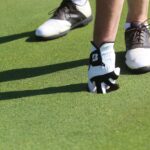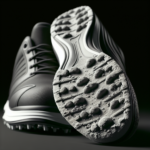
Golf shoes are more than just a stylish addition to your golfing attire – they play a crucial role in your performance on the course. But have you ever wondered just how important the type of material used in their construction really is? From providing traction to ensuring comfort and durability, the material of golf shoes can make or break your game. In this article, we will explore the significance of material in the construction of golf shoes and how it impacts your swing, stability, and overall playing experience. So, let’s lace up those shoes and discover the secret behind their construction!

Importance of Material in Golf Shoes
Enhancing Performance and Comfort
When it comes to golf shoes, the type of material used in their construction plays a crucial role in enhancing both performance and comfort on the golf course. The right materials can greatly impact your overall experience and ultimately contribute to better play. From the upper to the midsole and outsole, each component is carefully designed and selected to provide the necessary support, stability, and flexibility required for optimal performance.
Durability and Longevity
Another key aspect where material choice matters is in the durability and longevity of golf shoes. Golfers are known to spend several hours on their feet, walking long distances and enduring various weather conditions. Therefore, it is essential to invest in golf shoes that are made from high-quality materials that can withstand the demands of the game. Durable materials will ensure that your shoes hold up well over time, providing value for your investment and allowing you to focus on your game rather than worrying about worn-out shoes.
Leather Materials
Leather has long been a popular choice for golf shoe materials due to its durability, breathability, and classic aesthetic. There are several types of leather commonly used in the construction of golf shoes, each with its own unique characteristics.
Full-Grain Leather
Full-grain leather is considered the highest quality and most durable type of leather. It is made from the top layer of the hide and is left in its natural state, making it exceptionally strong and resistant to wear and tear. Golf shoes made from full-grain leather provide excellent support and comfort while maintaining a polished appearance.
Top-Grain Leather
Top-grain leather is slightly lower in quality than full-grain leather, but still offers durability and a refined look. It is often treated to improve its resistance to water and stains, making it a practical choice for golfers who frequently play in wet conditions. Top-grain leather golf shoes strike a balance between performance and style.
Nubuck Leather
Nubuck leather is similar to full-grain leather but has been buffed to create a soft, velvety texture. This type of leather is often used in golf shoes to enhance their visual appeal and provide added comfort. Nubuck leather requires regular maintenance to preserve its appearance, but its supple feel makes it an enticing option for golfers seeking both style and comfort.
Synthetic Leather
While leather materials offer a traditional and luxurious feel, synthetic leather has gained popularity in recent years due to its versatility and affordability. Synthetic leather golf shoes are often made from polyurethane or polyethylene materials that mimic the look and feel of genuine leather. These shoes are often more lightweight and require less maintenance, making them a practical choice for golfers seeking performance and convenience.
Synthetic Materials
In addition to leather, golf shoe manufacturers also incorporate various synthetic materials into their designs to provide specific benefits.
Microfiber
Microfiber is a synthetic material made of superfine filaments that can closely mimic the softness and breathability of natural materials. Golf shoes made with microfiber offer excellent moisture-wicking properties, keeping your feet dry and comfortable throughout your round. This material is also highly durable, resistant to stretching, and easy to clean.
Polyester
Polyester is a common synthetic material used in golf shoes due to its lightweight nature and ability to retain its shape even after extended use. Golf shoes made from polyester are known for their breathability and quick-drying properties, which are particularly advantageous in hot and humid conditions. Additionally, polyester is often mixed with other materials to enhance their overall performance.
Mesh
Mesh is a popular synthetic material known for its exceptional breathability and ventilation. Golf shoes with mesh uppers allow air to circulate around your feet, preventing excess heat and moisture buildup. This feature is especially beneficial in warm weather, keeping your feet cool and comfortable throughout your round. Mesh materials are typically lightweight as well, adding to the overall comfort of the shoe.
Waterproof Membranes
To combat wet conditions and protect your feet from moisture, golf shoe manufacturers often incorporate waterproof membranes into their designs. These membranes are typically made from synthetic materials such as Gore-Tex or eVent, which offer excellent water resistance while still allowing moisture to escape, preventing your feet from becoming sweaty and uncomfortable. Waterproof membranes are a must-have for golfers who frequently play in rainy or dewy conditions.
Midsole and Outsole Materials
The midsole and outsole of a golf shoe determine its stability, cushioning, and traction. Choosing the right materials for these components is essential for a comfortable and reliable shoe.
EVA (Ethylene-Vinyl Acetate)
EVA is a lightweight and flexible material commonly used in the midsoles of golf shoes. It provides excellent cushioning and shock absorption, reducing the impact on your feet and joints during each step. EVA midsoles are valued for their comfort and responsiveness, allowing for a smooth and natural stride on the golf course.
TPU (Thermoplastic Polyurethane)
TPU is a durable and supportive material often used in the outsoles of golf shoes. It offers excellent stability and traction, ensuring a secure grip with the ground throughout your swing. TPU is highly resistant to wear and tear, making it suitable for golfers who frequently play on various terrains and conditions.
Rubber
Rubber outsoles are a popular choice for golf shoes due to their versatility and grip. Golfers rely on the traction provided by rubber outsoles to maintain balance and stability during their swings. Rubber is known for its excellent durability and resistance to abrasion, making it suitable for long-lasting performance on the golf course.
Carbon Fiber
Carbon fiber is a lightweight and ultra-strong material that is increasingly being used in high-performance golf shoes. It offers exceptional stability and support, maximizing energy transfer during each step and swing. Carbon fiber outsoles provide a responsive feel and enhanced power, allowing golfers to generate more distance and accuracy. Although more expensive than other materials, carbon fiber is favored by professional golfers and serious amateurs seeking top-of-the-line performance.

Specialized Materials
In addition to the main components of golf shoes, there are specialized materials that serve specific purposes to enhance a golfer’s experience on the course.
Waterproofing Materials
Playing golf in wet conditions is inevitable for many golfers, which is why having waterproof shoes is essential. Various specialized materials, such as Gore-Tex or proprietary waterproofing technologies, are used to make golf shoes water-resistant. These materials create a barrier that prevents water from seeping into the shoe while still allowing moisture inside the shoe to escape. Waterproofing materials offer peace of mind, ensuring that your feet stay dry and comfortable even in the most challenging weather conditions.
Breathable Fabrics
Breathability is crucial for golf shoes, especially in warm weather or during physically demanding rounds. Fabrics such as mesh and certain synthetic materials are used in the construction of golf shoe uppers to promote airflow and ventilation. These breathable fabrics allow heat and moisture to escape, preventing sweaty and uncomfortable feet. Golf shoes with breathable fabrics ensure that your feet stay cool, dry, and odor-free, allowing you to focus on your game with maximum comfort.
Importance of Fit and Support in Golf Shoes
While the choice of materials is essential, the fit and support provided by golf shoes are equally important factors that can influence overall performance and comfort on the course.
Insole Materials
The insole, or footbed, of a golf shoe contributes significantly to its comfort and support. Golf shoes often feature cushioned insoles made from materials such as memory foam, EVA, or gel. These materials contour to the shape of your feet, providing customized comfort and shock absorption. The right insole material can alleviate pressure points and reduce foot fatigue, allowing you to play your best round without discomfort.
Arch Support
Proper arch support is crucial for maintaining stability and preventing foot and leg discomfort during a round of golf. Many golf shoes incorporate arch support features, such as molded footbeds or removable inserts, to cater to different arch heights and provide the necessary support. Arch support materials can vary from EVA foam to specialized gel or cushioning technologies, ensuring that your feet are well-supported throughout your swing.
Ankle Support
Golfers often face the challenge of maintaining stability and preventing ankle injuries. Golf shoes with adequate ankle support can help address this concern. The upper materials, design, and lacing systems play a role in ankle support. Leather golf shoes, for example, provide more ankle stability compared to shoes made with softer materials. Golfers with ankle issues may also consider high-top golf shoe designs or shoes with additional ankle support features for added protection and stability.

Considerations for Different Weather Conditions
Weather conditions can vary greatly throughout the year, and golfers need to be prepared for the challenges they may face on the course.
Cold and Wet Weather
In cold and wet weather conditions, it is crucial to have golf shoes that can provide warmth and protection. Choosing golf shoes with waterproof materials or waterproof membranes is essential to keep your feet dry in the rain or morning dew. Insulated options or shoes with thicker linings can also help keep your feet warm in colder temperatures. Additionally, golf shoes with excellent traction on wet surfaces, such as rubber or cleated soles, will provide stability and prevent slips on damp or muddy terrains.
Hot and Dry Weather
Golfing in hot and dry weather can be physically demanding, and your choice of golf shoes can make a significant difference in your comfort. Look for shoes with breathable materials, such as mesh uppers or synthetic fabrics, to allow for airflow and prevent overheating and sweating. Lightweight and well-ventilated golf shoes will help keep your feet cool and comfortable during long rounds in high temperatures. Additionally, golf shoes with moisture-wicking properties and cushioned insoles can help manage sweat and reduce foot fatigue.
Impact of Material on Traction
Traction is a crucial aspect of golf shoes as it determines the golfer’s stability and ability to maintain grip during the swing.
Cleated vs Spikeless Soles
Golf shoes traditionally came with metal spikes or cleats, which offered excellent traction on the grass. However, modern golf shoes now provide alternative options with spikeless soles. Cleated soles have small metal or plastic spikes strategically placed to distribute weight and enhance grip, especially in wet or hilly terrains. Spikeless soles, on the other hand, have a series of nubs or lugs that provide traction and stability without the use of spikes. Both types of soles have their advantages, and the choice depends on personal preference and the golf course conditions you typically encounter.
Grip Technology
To enhance traction and stability, many golf shoe manufacturers incorporate advanced grip technologies into the design of their soles. These technologies utilize specialized patterns, materials, or features to maximize contact with the ground and prevent slipping. Some examples of grip technologies include multidirectional traction, strategically placed lugs or nubs, and proprietary rubber compounds. These advancements enable golfers to maintain a firm foundation throughout their swing, enhancing power transfer and consistency.
Innovations in Golf Shoe Materials
As technology continues to advance, golf shoe manufacturers are constantly exploring new materials and techniques to improve performance, comfort, and sustainability.
Lightweight Materials
Golfers often spend many hours on their feet, walking long distances during a round. Therefore, lightweight golf shoe materials are highly sought after. The use of innovative synthetic materials, such as microfiber and mesh, helps reduce the overall weight of the shoe without compromising on durability or support. Lightweight golf shoes promote agility, ease of movement, and less fatigue over the course of a round.
Responsive Cushioning
Cushioning plays a vital role in ensuring comfort and minimizing impact on the feet and lower body. In recent years, golf shoe manufacturers have introduced responsive cushioning technologies that provide additional energy return and shock absorption. Materials such as specialized foams, gels, or air pockets are strategically placed within the midsole or insole to enhance cushioning and responsiveness. Responsive cushioning materials help golfers maintain optimal energy levels, reduce fatigue, and minimize the risk of injury.
Sustainable Materials
With a growing emphasis on sustainability, golf shoe manufacturers are increasingly turning to eco-friendly materials and manufacturing processes. Recycled materials, such as post-consumer plastics or reclaimed rubber, are used in the construction of golf shoes. Environmentally friendly manufacturing techniques, such as water-based adhesives or reduced carbon emissions, are also being adopted. Choosing golf shoes made from sustainable materials not only benefits the environment but also supports companies committed to reducing their ecological footprint.
Importance of Proper Maintenance
To ensure that your golf shoes continue to perform at their best and last for a long time, proper maintenance is crucial.
Cleaning and Conditioning
Regularly cleaning your golf shoes not only keeps them looking their best but also helps maintain their performance. Use a soft brush or cloth to remove dirt and debris from the upper and outsole after each round. If your golf shoes are made from leather, consider using a leather cleaner and conditioner to keep the material supple and prevent cracking. For synthetic materials, mild soap and water are usually sufficient. Allow your shoes to air dry thoroughly before storing them.
Storing and Drying
Proper storage and drying are essential for preserving the shape and condition of your golf shoes. After cleaning, make sure your shoes are completely dry before storing them to prevent the growth of mold or mildew. Avoid storing golf shoes in extremely hot or humid areas, as this can damage the materials. Consider using a shoe tree or stuffing your shoes with newspaper to help them retain their shape. Storing your golf shoes in a cool, dry place away from direct sunlight will help maintain their integrity and extend their lifespan.
In conclusion, the type of material used in the construction of golf shoes plays a significant role in enhancing performance, providing comfort, ensuring durability, and supporting the golfer’s feet. From leather to synthetic materials, each has its advantages and characteristics that cater to different preferences and playing conditions. The proper fit, support, and specific features, such as waterproofing or breathability, contribute to an overall enjoyable golfing experience. Additionally, traction, weight, and advancements in materials technology continue to drive innovation in the golf shoe industry. By selecting the right materials and properly maintaining your golf shoes, you can ensure that they perform optimally and last for many rounds to come.





